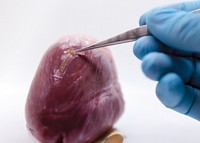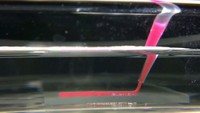Advertisement
Grab your lab coat. Let's get started
Welcome!
Welcome!
Create an account below to get 6 C&EN articles per month, receive newsletters and more - all free.
It seems this is your first time logging in online. Please enter the following information to continue.
As an ACS member you automatically get access to this site. All we need is few more details to create your reading experience.
Not you? Sign in with a different account.
Not you? Sign in with a different account.
ERROR 1
ERROR 1
ERROR 2
ERROR 2
ERROR 2
ERROR 2
ERROR 2
Password and Confirm password must match.
If you have an ACS member number, please enter it here so we can link this account to your membership. (optional)
ERROR 2
ACS values your privacy. By submitting your information, you are gaining access to C&EN and subscribing to our weekly newsletter. We use the information you provide to make your reading experience better, and we will never sell your data to third party members.
Materials
Copying Sea Cucumber's Cool Trick
New material switches from stiff to flexible when exposed to water
by Celia Henry Arnaud
April 8, 2008

Sea cucumbers can rapidly alter the stiffness of their skin in response to environmental cues. Inspired by these creatures, polymer scientists at Case Western Reserve University, in Cleveland, have mimicked this trick in an artificial system. Team member Jeffrey R. Capadona reported their findings this week to the Division of Polymer Chemistry at the ACS national meeting in New Orleans. They also published the work last month in the journal Science (2008, 319, 1370).

The stiffness of a sea cucumber's skin is governed by interactions between collagen fibers. The team led by Christoph Weder and Stuart J. Rowan achieves the same effect by embedding cellulose nanofibers, or "whiskers," in a rubbery polymer matrix. So far, they have tried two matrices—an ethylene oxide-epichlorohydrin copolymer and poly(vinyl acetate).
The surface of the cellulose fibers is dotted with hydroxyl groups. In a network of these nanofibers, wherever the nanofibers intersect, there are hydrogen bonds, Weder said. "The fibers want to stick to each other like there's no tomorrow."
The hydrogen bond network makes the material rigid, but that network can be disrupted by adding water. The material doesn't simply soak up water and swell like a sponge. Instead, the water forms hydrogen bonds with the nanofibers and decouples the whiskers. As a result, the composite material becomes flexible.
Marek W. Urban, professor of polymer science at the University of Southern Mississippi, said the work "demonstrates how interplay of different chemical species and their manipulation will lead to tremendous responses."
Brent S. Sumerlin, assistant professor of chemistry at Southern Methodist University, added that the team has managed to "elegantly reproduce an inherently complex natural phenomenon with straightforward polymer science."
Weder and Rowan are collaborating with Dustin J. Tyler, a biomedical engineer at Case Western, to fashion the material into microelectrodes that can be implanted in the brain for use as part of an artificial nervous system. Such implants must be stiff enough to be inserted into the brain, but once there, they need to be soft enough not to damage the surrounding tissue. The brain's aqueous environment is enough to trigger the switch from rigid to flexible.
The team hopes to devise other switchable materials that use different cues, such as light or electrical impulses, to trigger the transition from stiff to flexible.
Rowan envisions a broad range of applications for such materials, from biomedical devices such as stents to protective clothing and even toys. "You could mold it into whatever shape you want and then make it rigid," he said. "You can imagine kids loving that sort of thing. I know I would have when I was younger."





Join the conversation
Contact the reporter
Submit a Letter to the Editor for publication
Engage with us on Twitter